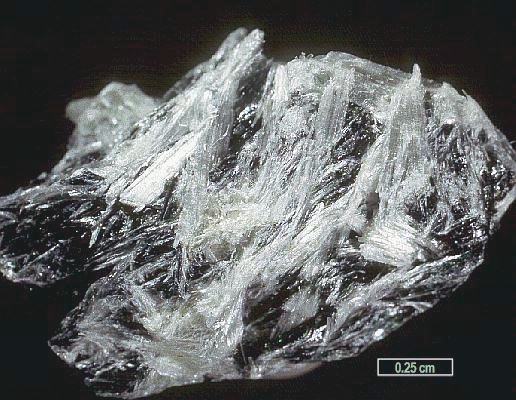
def. Jimthompsonite:
1. A magnesium and iron-rich silicate mineral found between the chlorite and actinolite zones of a metamorphosed ultramafic body. Jimthompsonite has the formula (Mg,Fe)5Si6O16(OH)2 and an orthorhombic structure. The mineral was named after James Burleigh Thompson, Jr., an eminent mineralogist and petrologist.
2. A wonderful example of scientists having fun with naming– and, in the process, classifying and better understanding– the world around them.

Jimthompsonite is a delightfully ridiculous mineral name. Minerals are often named after people, usually for the people who first discovered them. For example, searching randomly through my mineralogy book, I come across mineral names such as Pentlandite (named for Joseph Barclay Pentland), Vivianite (named for John Henry Vivian), and Covellite (named for Nicola Covellite).
Minerals are also commonly named after places, often their “type locality,” a notable place where the mineral occurs or was first discovered. For example, Andalusite is named for Andalusia, Spain. Mineral names are also sometimes taken from colloquial, historical names– sometimes modified– which existed prior to the mineral being classified scientifically. For example, Beryl comes from Ancient Greek.
Sometimes, minerals that are named in honor of people end up with ridiculous names such as “jimthompsonite.” Why jimthompsoite? Well, thomsonite was already taken, and I suppose thompsonite and thomsonite would have been somewhat confusing. Jamesonite was also already taken. I suppose jamesthompsonite was a slightly more formal option, but for whatever reason the mineral namers went with jimthompsonite, which is simply delightful and probably more reflective of Prof. Thompson, who apparently went by Jim rather than James.

What’s an even more ridiculous mineral name than jimthompsonite? Clinojimthompsonite, also named after Jim Thompson.
Ridiculous scientific names are not just limited to minerals. Just look at some of the ridiculous Element names (for example, Californium) and asteroid names (for example, #12426 is named “Raquetball”). Isn’t discovering and naming things fun? One of the funnest parts of science, I think.
Here are a few more ridiculous and fun mineral names:
Armalcolite: A mineral discovered on the moon and named for astronauts Armstrong, Aldrin, and Collins.
Znucalite: A mineral rich in the elements Zn, U, and Ca. Sounds like a Dr. Suess mineral, doesn’t it?
Cummingtonite: Supposedly named for the town of Cummington, Massachusetts. Uh-huh.. sure… 🙂
Coffinite: A halloween mineral? It’s uranium-rich and radioactive, so be careful…

Feel free to leave other fun mineral names in the comments!
LikeLike
Whewellite : named after William Whewell (1794-1866), an English mineralogist. http://www.mindat.org/min-4276.html
LikeLike
My favorite is hafnon, the hafnium analogue of zircon. Some people like eveite, which was named via false analogy: it is the manganese analogue of adamite.
By the way, I had JBT as a professor when I was at Harvard; he used to stare at the slate blackborad and circle the pyrites in it. A brilliant mineralogist, he invented the notion of polysomatic series, of which jimthompsonite was an early example.
LikeLike
Wow- that’s great that you had Jim Thompson as a professor! I looked around the web to see if there was any way I could contact him, but I don’t think he’s on Harvard’s website.
LikeLike
The most interesting thing about jimthompsonite is that it is a biopyribole, but not a mica, a pyroxene, or am amphibole. The structure is similar to the single- & double-chain silicates but not continuous like the sheet silicate structures. If memory serves, Jim Thompson was the first to predict the existence of minerals with more than 2 linked chains, and the first one found was named after him. I believe jimthompsonite is a triple-chain silicate.
LikeLike
?¡ãYour web site is ultra healthy and helpfull.Thanks?¡À
LikeLike
Thanks for your article. I would also love to say that your health insurance specialist also utilizes the benefit of the particular coordinators of a group insurance cover. The health agent is given a list of benefits desired by anyone or a group coordinator. Such a broker does is search for individuals or perhaps coordinators that best fit those requirements. Then he presents his ideas and if all parties agree, this broker formulates an agreement between the 2 parties.
LikeLike
You smacked the nail on the head there, never was a truer word spoken! Good stuff!
LikeLike